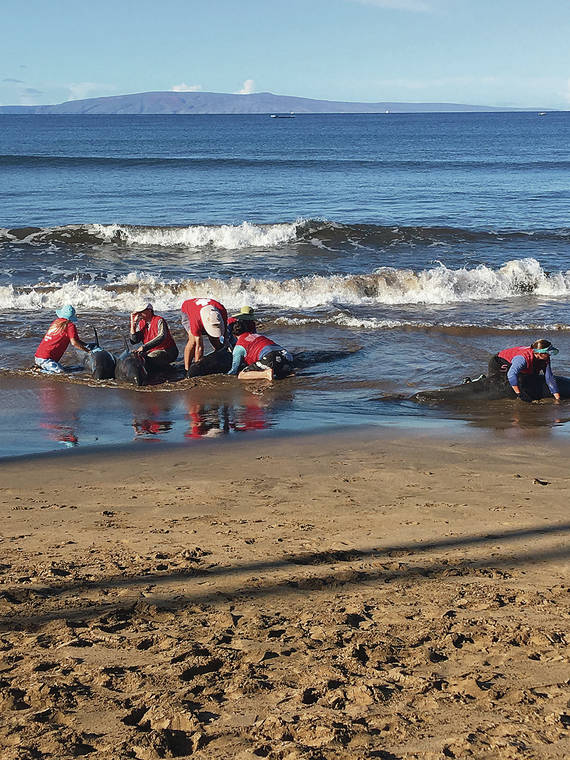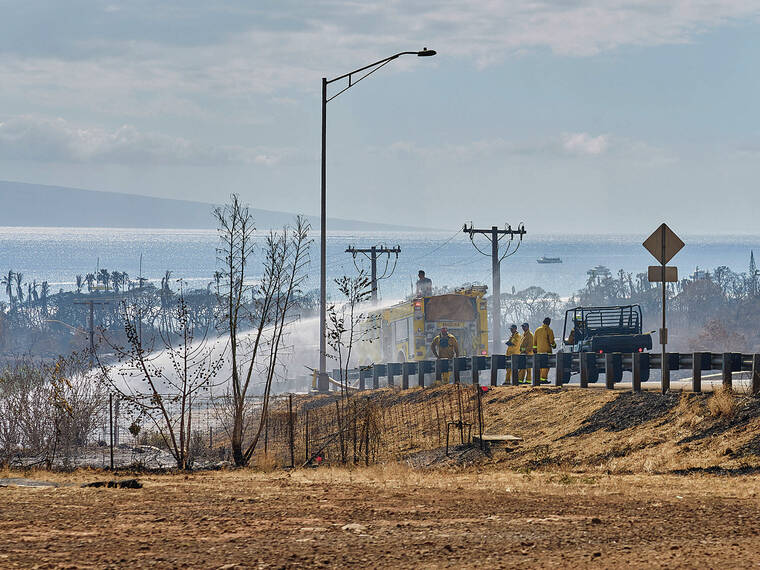Dead whales at Maui’s Maalaea Bay were likely ill

COURTESY OF VERNON KALANIKAU
Ten melon headed whales beached themselves last month at Sugar Beach, near Kihei, Maui.
While initial findings on dead whales that stranded themselves on a Maui beach last month indicate they were likely sick, another group has been hanging out at Maalaea Bay.
The beached whales were identified as pygmy killer whales, according to National Oceanic and Atmospheric Administration officials, who shared their findings Thursday.
Four were euthanized, while six were refloated into deeper water. A dead calf that was found near the group later that day suffered from pneumonia.
NOAA officials do not know — and do not think — the six whales of the same species at Maalaea Bay are the same as those that were refloated, based on dorsal fin identification.
The Pacific Whale Foundation on Maui is working with NOAA to assess the whales via drone footage.
“We don’t know exactly why these particular whales are milling in Maalaea Bay right now,” said David Schofield, NOAA regional marine mammal stranding response coordinator. “From drone footage, it appears to be four healthier animals and maybe two debilitated animals. It seems like there’s some caregiving behavior.”
Don't miss out on what's happening!
Stay in touch with breaking news, as it happens, conveniently in your email inbox. It's FREE!
In 2009, he said, another six whales were also observed caring for one sick individual over a three-week period.
On Aug. 29 a NOAA team responded to 10 stranded whales Opens in a new tab in front of the Sugar Beach Resort in Kihei, Maui. A dead whale calf, about 3 to 6 months old, washed ashore nearby later that afternoon.
Officials initially thought they were melon-headed whales, but necropsy results confirmed they were pygmy killer whales, a protected species found primarily in deep waters of the tropics and subtropics.
Upon assessment, the team decided to try refloating the whales — which weigh about 300 pounds — back to the ocean, starting with the six strongest, but learned shortly after that they had re-stranded about a half-mile away. Meanwhile, a tiger shark was sighted in the area.
The team decided then that the best course of action was to euthanize the four remaining at the beach. The decision was made after much consideration, said Schofield, factoring in animal welfare and public safety.
The team made another effort to refloat the six re-stranded whales, this time with Jet Skis to herd them to deeper water. Schofield said he is not 100% sure it worked, but said, “It’s our hope that those whales made it out safely.”
Researchers do not know much about pygmy killer whales Opens in a new tab, which are typically found in deep waters.
They are known to travel in groups of between 10 and 40 individuals, and are rarely found near shore, according to Dr. Gregg Levine, a NOAA contract veterinarian. They usually rest during the day and fish at night.
“We know from our research partners that they have high social bonds that can last for decades,” he said.
Upon arrival on-site in Maui, he assessed the whales and said they were stressed.
“They were in shock,” he said. “But we did not see any immediate signs of illness or injury. After short deliberation we decided that immediate release of these animals was the most appropriate.”
That’s when the team tried to refloat the whales, and with every hour that passed, the animals were getting more stressed.
Kristi West, an associate researcher at the Hawaii Institute of Marine Biology Opens in a new tab, said all five of the animals had some degree of lung abnormalities and empty stomachs, indicating they may have been too sick to dive for prey.
Every animal also had enlarged lymph nodes indicating they were fighting off some kind of infection. Only the calf, however, was confirmed to have pneumonia.
Among the whales necropsied were the calf, a lactating female, a pregnant female, an immature female and an immature male, according to West.
Genetic testing is underway to better understand the relationship between the calf and the other four whales. West said the lab also was waiting for histopathology results, which can offer greater insight into diseases, including morbillivirus and toxoplasmosis.
The team also conducted a specialized, inner ear test that will help determine whether the animals were exposed to acoustic trauma prior to stranding. Results, however, take at least four to six months.




